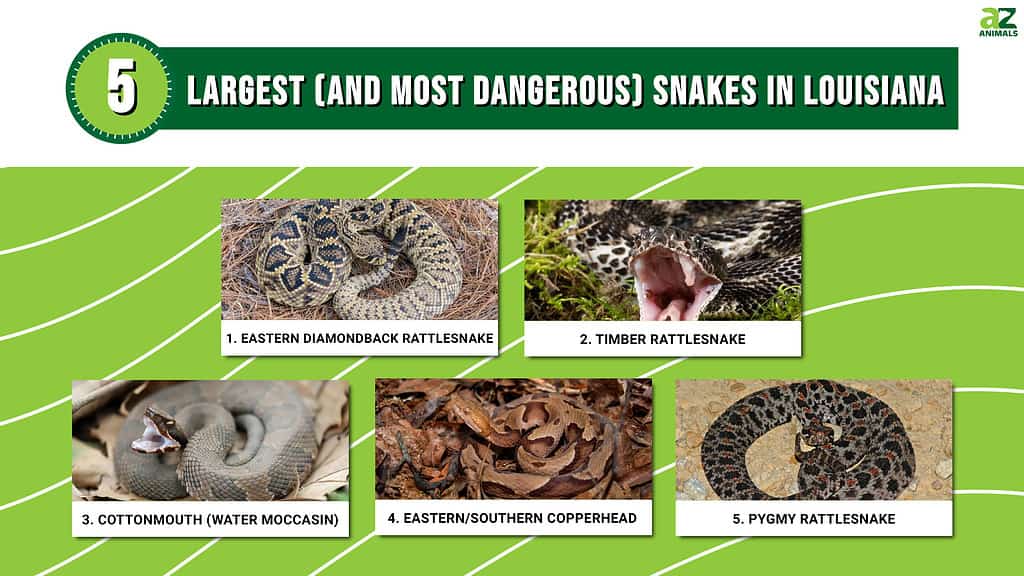
Louisiana is known for having a wide variety of animal life, and for the kind of warm weather, which is particularly key for reptiles like snakes! In fact, there are over fifty distinct species of snakes in Louisiana. But surprisingly, only a few of them are venomous. But which of these venomous snakes are the biggest and deadliest? The top five largest (and most dangerous) snakes in Louisiana are the copperhead, the cottonmouth, the pygmy rattlesnake, the timber rattlesnake, and the eastern diamondback rattlesnake. But which is the biggest, and which is the deadliest? We are counting them down right here!
The Top Five Largest (And Most Dangerous) Snakes In Louisiana
There are over fifty species of snakes found in Louisiana, which has warm temperatures and ideal conditions to keep any reptile happy. Thankfully, only seven of them are venomous! In this section, we are counting down Louisiana’s top five largest (and most dangerous) snakes, starting with a rattlesnake that may not be the biggest or deadliest, but still has a painful bite that could cost you a limb!
5. Pygmy Rattlesnake
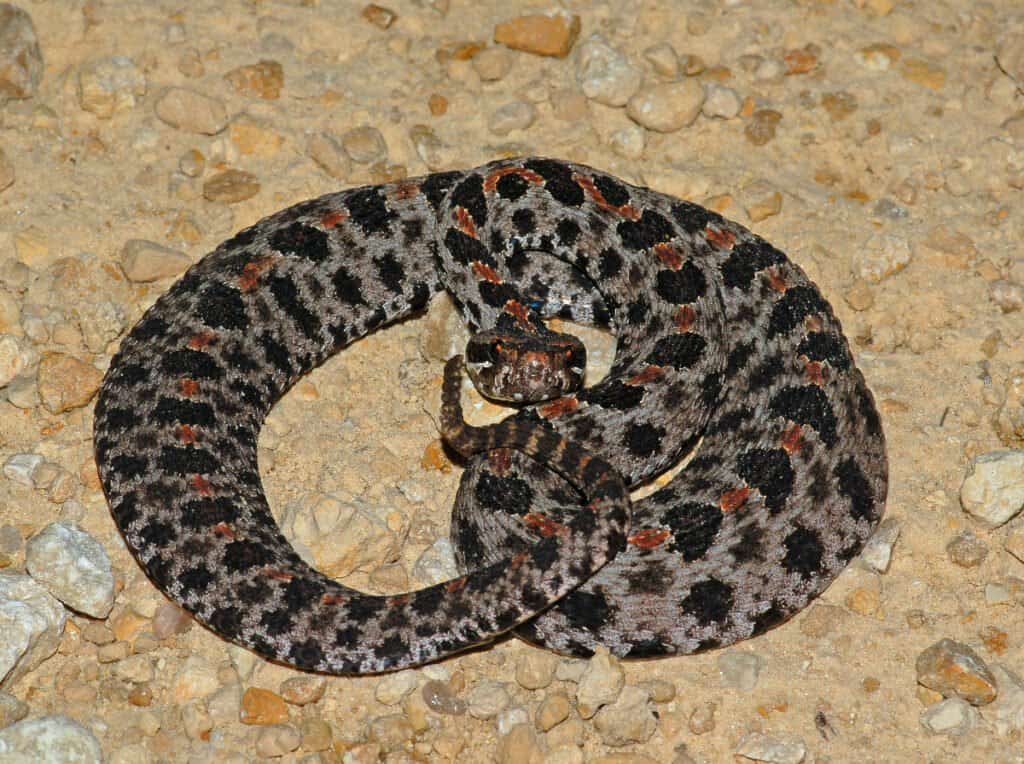
The pygmy rattlesnake is the fifth largest venomous snake in Louisiana.
©Gerald A. DeBoer/Shutterstock.com
| Size | 12-24 inches long |
| Habitat | Urban or suburban locations, landscaping, brush |
| Venom | Rarely deadly, but can result in lost fingers or limbs without medical care |
| Behavior | Moderately aggressive, often attacks with little warning, and rarely rattles |
This species can be identified by its elongated body and broad head. The pygmy rattlesnake is grey overall with darker blotching and small reddish-brown dots. This is one of the less common species of snakes that are attracted to urban areas and backyards, so Louisiana homeowners should be vigilant!
While this is the smallest of the three rattlesnake species found in Louisiana, they still have a painful bite. This species cannot produce enough venom to kill an adult, but without medical care, you could lose a finger or even a limb!
4. Eastern/Southern Copperhead
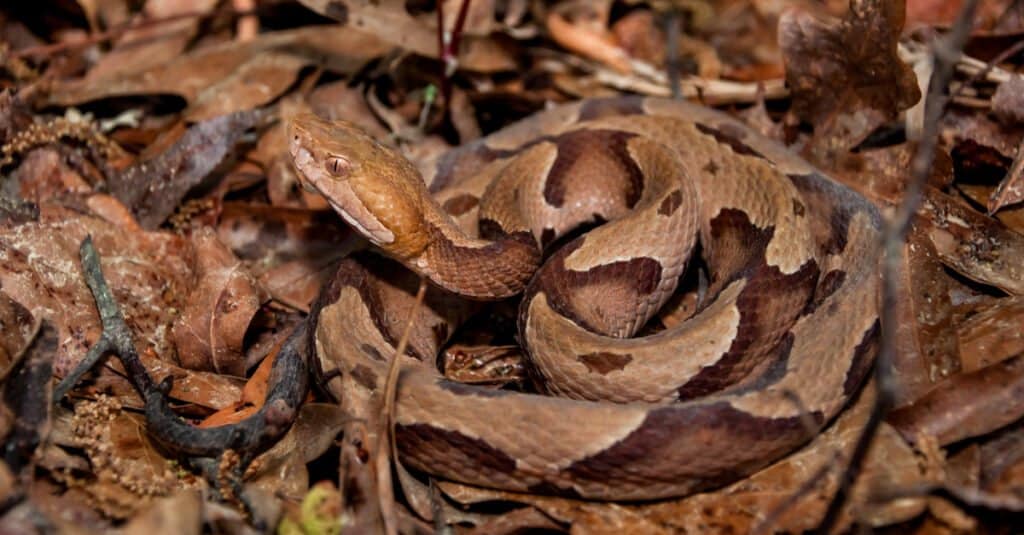
The Eastern/Southern copperhead is the fourth largest venomous snake in Louisiana.
©Jay Ondreicka/Shutterstock.com
| Size | 24-36 inches long |
| Habitat | Rocky or high elevations and marshlands |
| Venom | Extremely painful but not deadly, risk of infection |
| Behavior | Extremely aggressive, strikes with no warning, blends well with surroundings |
The copperhead is named for its overall reddish-brown coloring and can be identified by the brown hourglass markings over the body. Copperheads are pit vipers, with characteristic triangular heads and slitted, catlike pupils.
Since this species prefers higher elevations, it prefers the rocky areas of Louisiana and is less common in the marshlands and swamps. Though not considered to be a common bite risk, when bites do occur, they are deadly. This is due to their ability to seamlessly blend into their surroundings and most bites occur through accidental contact.
3. Cottonmouth (Water Moccasin)
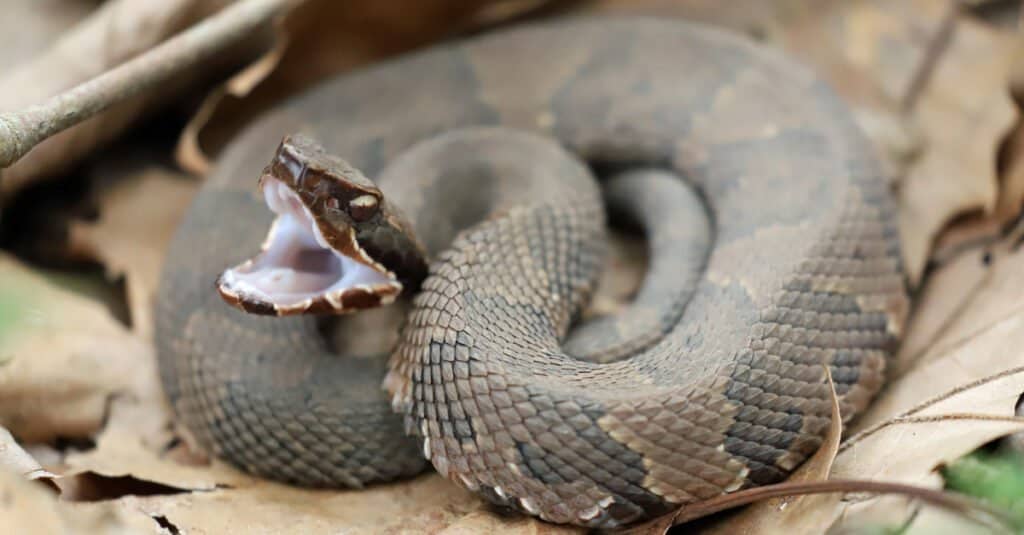
Cottonmouths are the third largest venomous snakes found in Louisiana.
©KF2017/Shutterstock.com
| Size | 20-48 inches long |
| Habitat | Swamps, marshlands, any location with standing water |
| Venom | Deadly without medical attention |
| Behavior | Moderately aggressive, raises and tilts their head back and opens their mouth wide to reveal a white “cotton-colored” interior as a warning. |
The cottonmouth is reddish-brown with black banding when young but may darken to grey or black with age. They can be most easily identified by their signature gaping mouth warning, which reveals the stark, cotton-colored white interior.
Like any other location with lots of standing water, cottonmouths are found throughout Louisiana’s marshes and swamps. Though most bites occur through accidental contact, the cottonmouth’s venom is deadly without fast medical intervention and can kill an adult human. Cottonmouth bites account for around one percent of the deadly snake bites in the United States every year.
2. Timber Rattlesnake
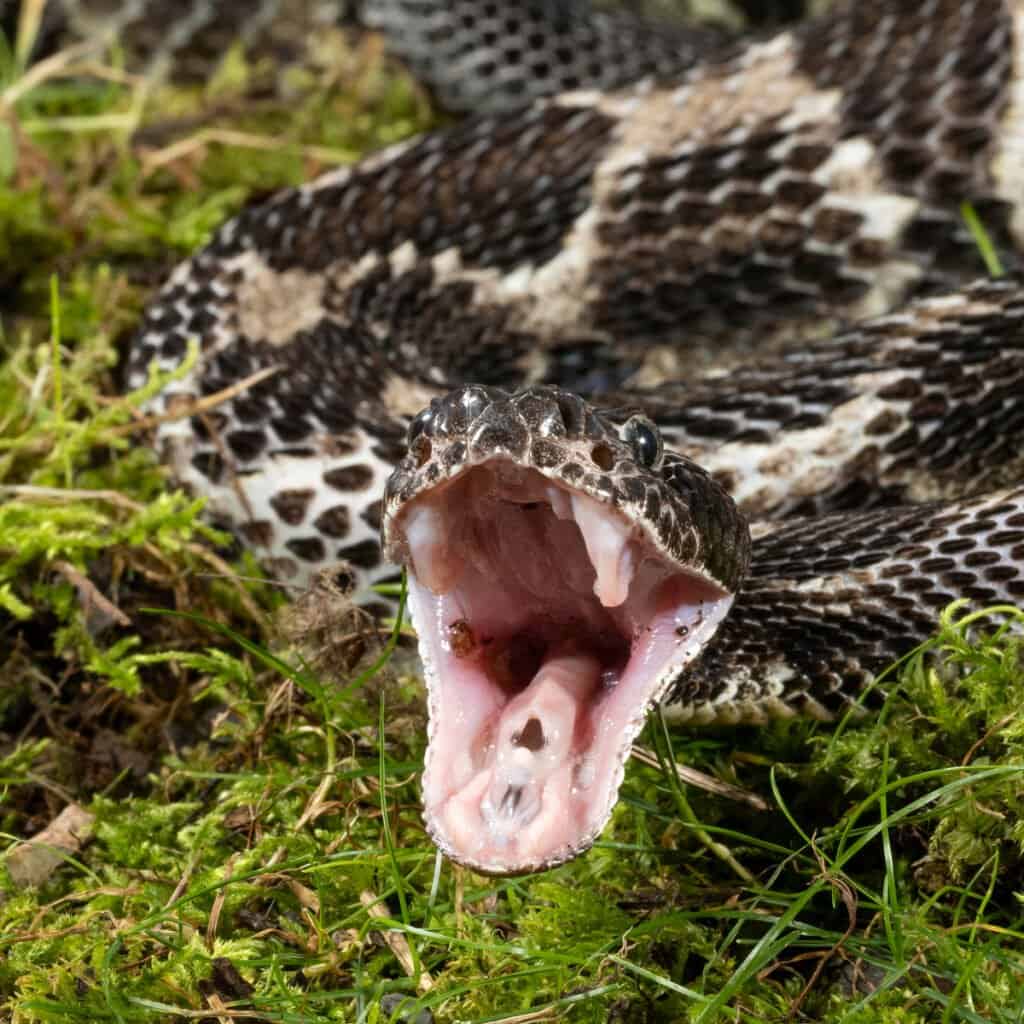
Timber Rattlesnakes are the second largest venomous snake in Louisiana, and the deadliest snake in the United States.
©Joe McDonald/Shutterstock.com
| Size | 36-60 inches long |
| Habitat | Forests, farms, agricultural areas, lowlands |
| Venom | Most concentrated venom of any U.S. snake, deadly without prompt medical attention |
| Behavior | Ambush hunter with a little warning prior to striking, running is advised |
A timber rattlesnake can be identified by their yellow-grey body, brown/black arrow markings, and reddish-brown stripe down the back. Timber rattlesnakes may also have darker brown banding over the entire body.
This species is found throughout the state of Louisiana and has the deadliest venom of all snakes in the United States. This species gives little to no warning before striking, and most experts agree that you should quickly flee once you hear the telltale rattle. This snake is one of the deadliest predators in Louisiana, and that list includes alligators!
1. Eastern Diamondback Rattlesnake

Eastern diamondback rattlesnakes are the largest venomous snake in Louisiana, as well as the entire United States.
©Chase D’animulls/Shutterstock.com
| Size | 36-72 inches long |
| Habitat | Dry areas, scrub, bushes, woodpiles, and occasionally near water |
| Venom | Deadly without prompt medical attention |
| Behavior | Mildly aggressive, lifts head slowly in warning along with rattle, strikes very quickly from up to four feet |
The largest and most dangerous snake in Louisiana is the eastern diamondback rattlesnake which has brown over the entire body, with a distinctive brown diamond pattern outlined in yellow. They can also be identified by the black markings striping the face, as well as the narrow shape and slitted eyes common in pit vipers.
The eastern diamondback rattlesnake is the largest venomous snake in the United States. Slow to attack but it strikes fast, and slowly backing away is recommended to escape a deadly bite. The diamondback is less widespread in the state than the timber rattlesnake and is not common in marshland. Diamondback rattlesnakes are found in drier areas throughout Louisiana and prefer to stay away from humans.
Up Next
- Discover 50+ Snakes Found In Louisiana (7 Are Venomous)
- Discover The 10 Largest Animals In Louisiana, And Where You’ll Find Them
- The Biggest Alligator Ever Found In Louisiana
The photo featured at the top of this post is © Joe McDonald/Shutterstock.com
Discover the "Monster" Snake 5X Bigger than an Anaconda
Every day A-Z Animals sends out some of the most incredible facts in the world from our free newsletter. Want to discover the 10 most beautiful snakes in the world, a "snake island" where you're never more than 3 feet from danger, or a "monster" snake 5X larger than an anaconda? Then sign up right now and you'll start receiving our daily newsletter absolutely free.
Thank you for reading! Have some feedback for us? Contact the AZ Animals editorial team.






